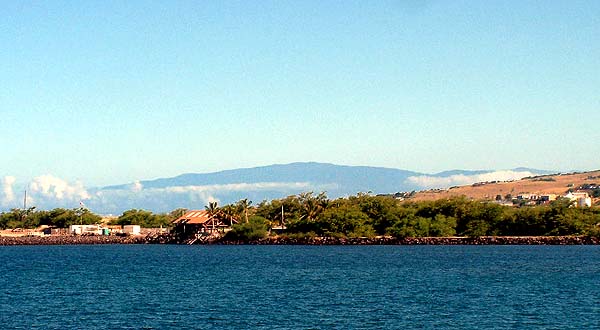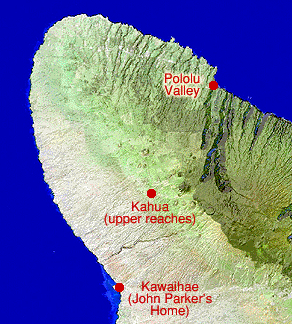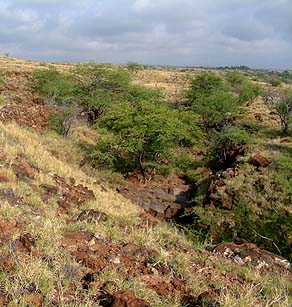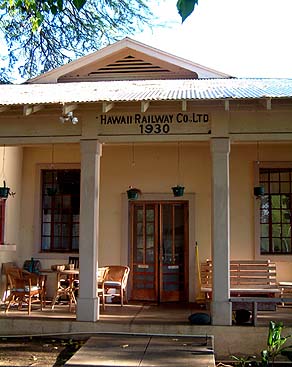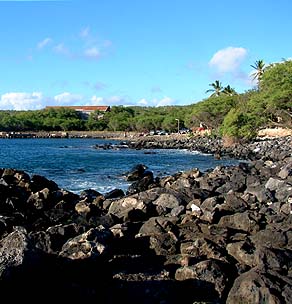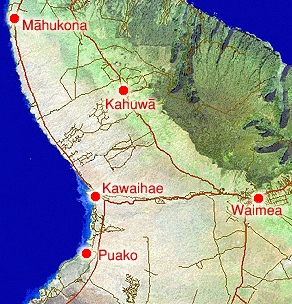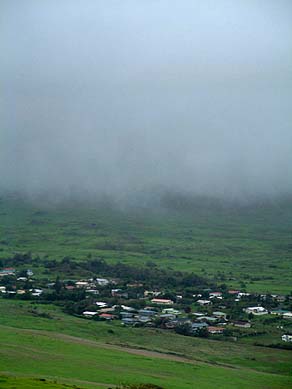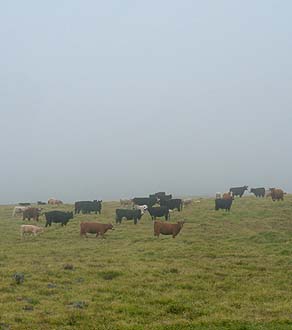 |
 |
 |
|||||
|
|
|||||||
|
|
|
|
“Throughout the Dynastic period,” Hannah remarks, “we see the rising of the great war chiefs of Maui and Hawai‘i. And because of the close proximity that the islands have to each other, from the South Kohala Coastline to Hana Maui, it seems as though the Kawaihae area is a hotly contested landscape.”
|
||
| |
||
“This of course is perhaps most closely represented to us with Kamehameha, who mated with so many women of Maui. The name most familiar to our ears is Ka‘ahumanu. But also there is Kaheiheimalie,and a strong connection, in the genealogies of Keopuolani, to the chiefs of Maui. "Then of course, in the next generation, Kauikeaouli—Kamehameha III—lived with Nahi‘ena‘ena at Lahaina. There again we have the royal children of Hawai‘i island going back to Maui as that ancestral touchstone. And when Kamehameha married with the women of Maui, one of the things that he accessed were their ‘aumakua. Kihawahine is one of those.”
|
|
|
“Around the time of Kamalalawalu and Lonoikamakahiki, two sisters coming from Maui arrived at Pololu: Kihalaninui and her sister Kapapaku‘iali‘i. They were going to visit Konokaimehala‘i, husband of Kihalaninui. They traveled from Pololu to Kahua. "I’m not sure where the trails are that they traveled, are in comparison to the Akoni Pule Highway and the mauka Road, or where we see the Kahua Ranch Headquarters today. But it’s said that Kihalaninui and Kapapaku‘iali‘i came from Pololu. At Kahua, one of the children of Kihalaninui died, and she was buried in a cave with a ki‘i [image] named Pili." Kapapaku‘iali‘i is said to have cried these words: Waiho i Kaea ka iwi o kamahele ("Left in Kaea, the bones of the traveler). This is a saying since applied to anyone who dies away from his homeland (Pukui 1983, #2906).
|
|
|
|
“These accounts come down to us through that wonderful book ‘Olelo No‘eau (Pukui 1983: #2906). But this story also comes down through the Parker lineage. One of the early Parker homes was in the same gulch in Kawaihae where John Young had his home. Whether it’s fortuitous, or just ancient rhythms continuing on through the generations, there is this account of John Parker marrying into a family that is part of this rhythm, this dynastic cycling between the war chiefs of Hawai‘i Island and the women of mana of Maui. "There’s a strong trend in that family for the first-born girl of a generation to be named Kihalaninui, and her immediately younger sister to carry the name Kapapaku‘iali‘i. And this carried on into our lineage. Thus I bear the name Kihalani, and this name Kihalani comes to us from Maui, via North and South Kohala. The ‘aumakua Kihawahine is the one referred to in our names, and the people of Lahaina still hold her in high and present-tense regard.”
|
||
|
|
||
While in the distant past, the many small ahupua‘a up the coast from Kawaihae would have been occupied, the only neighbor in that direction in more recent times was Mahukona. Lala recalls, “The next village was Mahukona. They had these stevedores who lived there. When the ships came in, they used to load the ship with sugar. All in bags. "A train used to come bring the sugar down, and store it in the warehouse. When they got enough loads, then the ships used to come in and pick it up. It was all labor. They had a Post Office there, though." “They had a whole colony of families that lived at Mahukona,” Pua recalls. “They had the Lincoln family, the Puhi family, the Cecil family. Oh, there was a whole town up there. But between here and there, nothing. Only up at Mahukona.” “The a road back then, it was kind of slow though,” Lani states. “You had to go up the hill. But when they opened the coast road, it’s much easier.”
|
|
|
Mary Pukui, in her collection ‘Olelo No‘eau, notes the following sayings:
Today, Mahukona is a favorite local swimming area, with beautiful dark lava setting off the bright colors of the reef fish.
|
Down the coast the other direction was Puako. "Oh, it was beautiful," Pua says. "I used to go to Puako, because my Dad worked for Mr. Robson Hind. They raised pug-nosed pigs. And I had to go help him do the feeding. And in the evening, the wild pigs were plentiful! We’d be driving along the highway and pretty soon my Dad would go ‘Look at that!’ and he would jump off the truck and chase that pig.” “My great grandfather raised sugar at Puako in the late 1800s," Billy says, "But about the turn of the century they gave up sugar. You see, they irrigated with the water from the wells at Puako, and they were slightly saline. It’s not really salty, but has enough salt in it so it can affect crops if you do not keep the salt level down. But they made that mistake, and the crop failed. “Once the kiawe trees came in, we had honey bees, and they produced quite a bit of honey at Puako. The Humuula would come offshore there, and we’d load the honey—it was all in five gallon cans—into the life boats to take them out to the mother ship.” Puako, as we will learn, is where the people of Kawaihae buried their dead.
|
|
|
|
|
Uphill from Kawaihae in one direction is Kahua, now often spelt "Kahua"; and in a different direction is Waimea. These upland areas are moister and there would have been agriculture going on here. Hannah states, "I believe that Waimea and those slopes were certainly important places to go, even before the town of Waimea as we know it, which I believe is surely associated with the early 19th century." But with its higher elevation (2670 feet, or 814 meters) Waimea was and still is known for its cold temperatures. This would appeal to Westerners, used to cooler climates. But in Hawaiian lore, Waimea is famous for its cold Kipu‘upu‘u rain, and fog:
|
||
|
|
||
|
|
|
Kahua today is the headquarters of the large Kahua Ranch. In olden times, however, such "uplanders" were spoken of disparagingly. [In the proverbs below, author Pukui uses the spelling 'Kahuwa']:
|
|
|
|
| “Into the early 20th century," Hannah points out, "we have the accounts of the fishing families of Kaupulehu in North Kona, and the stories of them coming down the coastline, sometimes to pick up supplies as far away as Kawaihae. And both their coming to Kawaihae and their returning to Kaupulehu being dependent upon the prevailing winds. "It was really a both sophisticated and extemporaneous working of that trade route—or of that shopping route, if you will—with occasionally having to make decisions where they would not put out, at the intended time, and it might be required that they would stay over, perhaps another day or so. So we see these people working according to a much different rhythm than we do today.”
|
||
|
|
||
|
|
|
|
|
|

|
| Kawaihae Home | Map Library | Site Map | Pacific Worlds Home |
|
|
|
|
|
|
|||
| Copyright 2006 Pacific Worlds & Associates • Usage Policy • Webmaster |
|||
